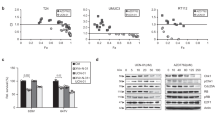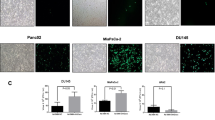Abstract
Studies have revealed that human adenovirus-encoded E1A protein promotes cell proliferation through the targeted interaction with cellular proteins that act as key negative regulators of cell growth. The targets of E1A protein include the retinoblastoma tumor suppressor protein (pRb). Because p202, an interferon (IFN)-inducible murine protein (52-kDa), negatively regulates cell growth in part through the pRb/E2F pathway, we tested whether the p202 is a target of the adenovirus-encoded E1A protein for functional inactivation. Here we report that the expression of E1A protein overcame p202-mediated inhibition of cell growth and this correlated with an alleviation of p202-mediated inhibition of the transcriptional activity of E2F. Furthermore, E1A protein relieved p202-mediated inhibition of the specific DNA-binding activity of E2F complexes, including those containing the pocket proteins. Additionally, the E1A protein bound to p202 both in vitro and in vivo and a deletion of four amino acids in the conserved region 2 (CR2) of E1A protein significantly reduced the binding of E1A to p202. Interestingly, ectopic expression of p202 under reduced serum conditions significantly reduced E1A-mediated apoptosis. Taken together, our observations provide support to the idea that the p202 and adenovirus E1A protein functionally counteract each other and E1A protein targets p202 to promote cell proliferation.
This is a preview of subscription content, access via your institution
Access options
Subscribe to this journal
Receive 50 print issues and online access
$259.00 per year
only $5.18 per issue
Buy this article
- Purchase on Springer Link
- Instant access to full article PDF
Prices may be subject to local taxes which are calculated during checkout






Similar content being viewed by others
References
Ackrill AM, Foster GR, Laxton CD, Flavell DM, Stark GR, Kerr IM . 1991 Nucl. Acids Res. 19: 4387–4393
Bagchi S, Raychaudhuri P, Nevins JR . 1990 Cell 62: 659–669
Brockmann D, Esche H . 1995 Curr. Top. Microbiol. Immunol. 199: 81–112
Chaturvedi V, Qin JZ, Denning MF, Choubey D, Diaz MO, Nickoloff BJ . 1999 J. Biol. Chem. 274: 23358–23367
Chellappan S, Kraus VB, Kroger B, Munger K, Howley PM, Phelps WC, Nevins JR . 1992 Proc. Natl. Acad. Sci. USA 89: 4549–4553
Choubey D . 2000 J. Biol. Regul. Homeost. Agents. 14: 187–192
Choubey D, Gutterman JU . 1997 Oncogene 15: 291–302
Choubey D, Lengyel P . 1992 J. Cell. Biol. 116: 1333–1341
Choubey D, Lengyel P . 1993 J. Interferon Res. 13: 43–52
Choubey D, Lengyel P . 1995 J. Biol. Chem. 270: 6134–6140
Choubey D, Li SJ, Datta B, Gutterman JU, Lengyel P . 1996 EMBO J. 15: 5668–5678
Choubey D, Snoddy J, Chaturvedi V, Toniato E, Opdenakker G, Thakur A, Samanta H, Engel D, Lengyel P . 1989 J. Biol. Chem. 264: 17182–17189
Condorelli G, Giordano A . 1997 J. Cell. Biochem. 67: 423–431
Cress WD, Nevins JR . 1996 Curr. Top. Microbiol. Immunol. 208: 63–78
Datta B, Li B, Choubey D, Nallur G, Lengyel P . 1996 J. Biol. Chem. 271: 27544–27557
Datta B, Min W, Burma S, Lengyel P . 1998 Mol. Cell. Biol. 18: 1074–1083
De Stancina E, McCurrach ME, Zindy F, Shieh SY, Ferbeyre G, Samuelson AV, Prives C, Roussel MF, Sherr CJ, Lowe SW . 1998 Genes Dev. 12: 2434–2442
D'Souza S, Xin H, Walter S, Choubey D . 2001 J. Biol. Chem. 276: 298–305
Dyson N . 1998 Genes Dev. 12: 2245–2262
Fattaey AR, Harlow Ed, Helin K . 1993 Mol. Cell. Biol. 13: 7267–7277
Flint J, Shenk T . 1997 Annu. Rev. Genet. 31: 177–212
Geng Y, Choubey D . 2000 J. Biol. Regul. Homeost. Agents 8: 263–268
Geng Y, D'Souza S, Xin X, Walter S, Choubey D . 2000 Cell Growth Diff. 11: 475–483
Gutterman JU, Choubey D . 1999 Cell Growth Diff. 10: 93–100
Harlow E, Whyte P, Franza BR, Schley C . 1986 Mol. Cell. Biol. 6: 1579–1589
Hertel L, Rolle S, De Andrea M, Azzimonti B, Osello R, Gribaudo G, Gariglio M, Landolfo S . 2000 Oncogene 19: 3598–3608
Jansen-Durr P . 1996 Trend Genet. 12: 270–275
Jones N . 1995 Curr. Top. Microbiol. Immunol. 199: 59–80
Kaelin Jr WG, Ewen M, Livingston DM . 1990 Mol. Cell. Biol. 10: 3761–3769
Kalvakolanu DVR, Bandyopadhyay SK, Harter ML, Sen GC . 1991 Proc. Natl. Acad. Sci. USA 88: 7459–7463
Koul D, Lapushin R, Xu HJ, Mills GB, Gutterman GU, Choubey D . 1998 Biochem. Biophys. Res. Commun. 247: 379–382
Lengyel P, Choubey D, Li S-J, Datta B . 1995 Semin. Virol. 6: 203–213
Lillie JW, Green M, Green MR . 1986 Cell 46: 1043–1051
Ludlow JW, Skuse GR . 1995 Virus Res. 35: 113–121
Melamed D, Tiegenbrun N, Yardin A, Kimchi A . 1993 Mol. Cell. Biol. 13: 5255–5265
Min W, Ghosh S, Lengyel P . 1996 Mol. Cell. Biol. 16: 359–368
Missero C, Filvaroff E, Dotto GP . 1991 Proc. Natl. Acad. Sci. USA 88: 3489–3493
Nevins JR . 1992 Science 258: 424–429
Nevins JR . 1995 Curr. Top. Microbiol. Immunol. 199: 25–32
Nevins JR, Leone G, DeGregori J, Jakoi L . 1997 J. Cell. Physiol. 173: 233–236
Peeper DS, Zantema A . 1993 Mol. Biol. Rep. 17: 197–207
Raychaudhuri P, Bagchi S, Devoto SH, Kraus VB, Moran E, Nevins JR . 1991 Genes Dev. 5: 1200–1211
Sang N, Giordano A . 1997 J. Cell. Physiol. 170: 182–191
Schneider RJ, Shenk T . 1987 Annu. Rev. Biochem. 56: 317–332
Smith K, Ying B, Ball AO, Beard CW, Spindler KR . 1996 Virology 224: 184–197
Wang H, Liu CJ, Lu Y, Chatterjee G, Ma XY, Eisenman RN, Lengel P . 2000 J. Biol. Chem. 275: 27366–27376
Weintraub SJ, Prater CA, Dean DC . 1992 Nature 358: 259–261
Weinberg RA . 1995 Cell 81: 323–330
Weinberg RA . 1996 Cell 85: 457–459
White E . 1995 Curr. Top. Microbiol. Immunol. 199: 34–58
Whyte P, Ruley HE, Harlow Ed . 1988 J. Virol. 62: 257–265
Yan DH, Wen Y, Spohn B, Choubey D, Gutterman JU, Hung MC . 1999 Oncogene 18: 807–811
Zantema A, van der Eb AJ . 1995 Curr. Top. Microbiol. Immunol. 199: 1–32
Zhang HS, Postigo AA, Dean DC . 1999 Cell 97: 53–61
Acknowledgements
We thank Drs J Nevins, P Dotto, J Germino, PE Branton, and KR Spindler for generously providing reagents. We also thank Dr Qin, and Scott Walter for the technical help. This work was supported by a grant (CA69031) from the National Institutes of Health (to D Choubey).
Author information
Authors and Affiliations
Corresponding author
Rights and permissions
About this article
Cite this article
Xin, H., D'Souza, S., Fang, L. et al. p202, an interferon-inducible negative regulator of cell growth, is a target of the adenovirus E1A protein. Oncogene 20, 6828–6839 (2001). https://doi.org/10.1038/sj.onc.1204844
Received:
Revised:
Accepted:
Published:
Issue Date:
DOI: https://doi.org/10.1038/sj.onc.1204844
Keywords
This article is cited by
-
Epigenetic silencing of multiple interferon pathway genes after cellular immortalization
Oncogene (2003)
-
Role of IFI 16, a member of the interferon-inducible p200-protein family, in prostate epithelial cellular senescence
Oncogene (2003)
-
Retinoblastoma (Rb) protein upregulates expression of the Ifi202 gene encoding an interferon-inducible negative regulator of cell growth
Oncogene (2003)



